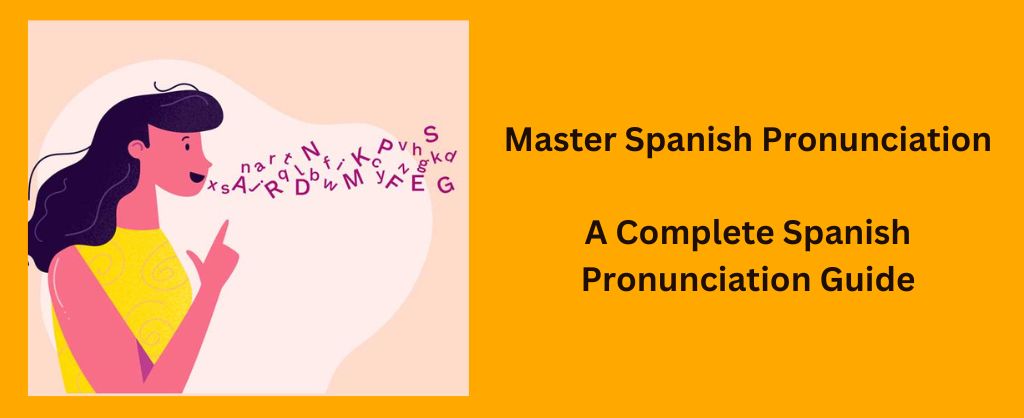An In-Depth Spanish Pronunciation Guide for Beginners

Learning to pronounce Spanish words correctly is an important part of becoming fluent in the language. Spanish has several sounds that can be tricky for English speakers, but with practice, you can master Spanish pronunciation.
This guide provides an overview of Spanish sounds, examples of pronunciation, and tips to help you speak Spanish clearly.
Spanish Sounds
Spanish pronunciation relies on clear articulation of both vowel and consonant sounds. This overview covers the key Spanish vowel and consonant sounds, contrasting them with English pronunciations.
Examples are provided in context to help English speakers recognize and properly enunciate the sounds necessary for intelligible Spanish speech.
Vowel Sounds
Spanish contains 5 vowel sounds that each have a distinct pronunciation. These vowels have a crisp, pure sound that differs from English vowel patterns. They are tense and clearly enunciated.
Mastering these vowel distinctions is key for proper Spanish pronunciation and comprehension.
The five Spanish vowel sounds are:
- A – Sounds like the a in “father”, but shorter. Ejemplo: casa (house)
- E – Sounds like the e in “met”. Ejemplo: tres (three)
- I – Sounds like the i in “machine”. Ejemplo: fin (end)
- O – Sounds like the o in “robot”. Ejemplo: dormir (to sleep)
- U – Sounds like the u in “rude”. Ejemplo: luz (light)
Consonant Sounds
While Spanish consonants are generally similar to English, there are some key distinctions English speakers must master. This includes sounds like the trilled “R”, aspirated “H”, and the guttural “J”.
Letters like “G” and “C” change pronunciation based on surrounding vowels. Becoming comfortable with these Spanish consonant distinctions takes practice for the English ear and mouth.
This section provides an overview of proper Spanish consonant articulation with examples in context.
- B – Sounds like the English b but is not voiced at the end of words. Ejemplo: cub (cube)
- C – Before e or i, sounds like th in “think”. Before a, o, u sounds like k. Ejemplo: cero (zero), casa (house)
- D – Sounds like the English d but is not voiced at the end of words. Ejemplo: verdad (truth)
- G – Before e or i, sounds like a harsh h. Before a, o, u sounds like the English g. Ejemplo: general, gota (drop)
- H – Always silent in Spanish. Ejemplo: hormiga (ant)
- J – Sounds like a guttural h. Ejemplo: jarabe (syrup)
- LL – Sounds like the y in “yes”. Ejemplo: llave (key)
- Ñ – Sounds like ny. Ejemplo: ñoño (geeky)
- R – Rolled or trilled r. Tap tongue against roof of mouth. Ejemplo: rotor (rotor)
- RR – Strongly trilled/rolled r. Ejemplo: carro (car)
- V – Sounds like the English b. Ejemplo: vivo (I live)
- X – Between vowels, sounds like ks. At the beginning of words, it sounds like s. Ejemplo: examen (exam), xilófono (xylophone)
- Z – Sounds like the s in “sun”. Ejemplo: zapato (shoe)
Watch the video to learn the pronunciation of all the letters:
Stress and Accents
Proper stress and accents are key to sounding natural when speaking Spanish. Here’s what you need to know:
Stress
- Spanish words are usually stressed on the second-to-last syllable (the penultimate syllable). For example: casa, difícil, felicidad.
- Words ending in a vowel, n, or s are stressed on the last syllable. For example: joven, acción, inglés.
- Stress typically occurs on long vowels and diphthongs. Short vowels in unstressed syllables are reduced to a schwa sound.
- Maintain the rhythmic structure of sentences by pausing slightly at commas and stressing important words.
Written Accents
Accent marks (acentos) indicate stress on a syllable that breaks the normal stress rules:
- Acute accent (á, é, í, ó, ú): Marks stress on the vowel. Example: jalapeño, útil.
- Tilde (ñ): Indicates a palatal n sound. Example: niño.
Accents differentiate meaning between words:
- él (he) vs el (the)
- tú (you) vs tu (your)
Accents are common on words ending in -n, -s, or vowel: ejemplo, canción, inglés
Tips for Stress and Accents
- Listen for and mimic native speaker rhythm and prominence.
- When stuck on a word, break it into syllables and identify which is stressed.
- Decode unfamiliar words by noting any accent marks.
- Memorize accent patterns for common irregular verbs like ser, estar, poder.
- Double check new vocabulary for accent marks to avoid learning incorrectly.
Mastering stress and accents will greatly improve the flow and intelligibility of your Spanish pronunciation.
Tips for Proper Spanish Pronunciation
- Imitate audio of native speakers, like in language learning apps, TV, or radio.
- Record yourself and compare to native speaker audio to identify problem sounds.
- Practice tap or trill of “R” with tongue exercises.
- Memorize small words illustrating each new sound.
- When struggling with a word, break it into syllables to identify stress and vowel sounds.
- Use a mirror to watch your mouth shape and tongue position for tricky sounds.
- Don’t be afraid to ask native speakers for feedback and practice conversations.
- Maintain proper posture and open mouth to facilitate clear enunciation.
- Sing along to music in Spanish to get a feel for sounds in context.
Mastering pronunciation is key for speaking Spanish clearly and gaining confidence in conversation. Be patient with yourself as you train your mouth and ears to distinguish the new sounds.
With regular practice and use of native audio resources, you’ll be able to pronounce Spanish as well as a native speaker.
Advanced Pronunciation for Fluent Spanish Speech
Once you have a grasp on the basic sounds of Spanish, you can focus on some of the more complex pronunciation rules for speaking at an advanced, fluent level. Here are some key areas to refine your accent:
Linking Words Together
In fast, natural Spanish speech, words blend together fluidly. Practice linking the end of one word into the start of the next:
- Las aguas – “lah-sah-gwahs”
- Quieres ir – “kyehr-reh-seer”
- Vamos a ver – “bah-moh-sah-vehr”
Linking maintains the flow of speech and sounds more natural.
Subtle Vowel Distinctions
Listen closely to distinguish between similar vowel sounds:
- I vs E – chimenea (chimney) vs ceniza (ash)
- E vs A – mesa (table) vs masa (dough)
- O vs U – todos (all) vs tudos (yours)
Hit these subtle sound differences to sound like a native speaker.
Knowing When Letters are Silent
In certain cases, letters are silent:
- H – Always silent, as in hormiga (ant)
- Ending D – Not pronounced, as in verdad (truth)
- U after G and Q – Does not make a sound, as in lingüística (linguistics)
Pay attention to when letters should not be pronounced to perfect your pronunciation.
Reduced Vowels
Unstressed vowels in the middle of words can be reduced to a shorter uh sound:
- Entendido = “ehn-tehn-dee-doh”
- Dificultad = “dee-fee-kool-tahd”
Listen carefully for these reduced sounds that make speech faster.
Intonation and Rhythm
- Spanish is less monotone than English. Inflect voice up and down.
- Stress rhythmic structure of sentence, pausing slightly at commas.
- Use rising pitch at the end of yes/no questions.
Mastering intonation gives your Spanish a lively, conversational style.
With a grasp of advanced pronunciation rules, you can take your Spanish abilities to the next level. Refine tricky distinctions, link between words, mind silent letters, reduce unstressed vowels, and use proper intonation.
Common Spanish Pronunciation Pitfalls for English Speakers
Spanish and English share the same alphabet, but their sound systems differ. Here are some of the most common Spanish pronunciation mistakes English speakers make:
Rolling R’s
Trilling or rolling the Spanish “R” takes practice. Start by whispering it to feel the tongue vibration. Or, practice the single tap of the alveolar flap “R” between vowels before working up to the longer trill.
Silent H
Avoid pronouncing Spanish “H”. The beginning “H” is always silent. Break the habit!
B vs V
The Spanish “B” and “V” sound nearly identical, unlike in English. Correct your tendency to differentiate them.
J, G, and X
The guttural Spanish “J”, hard “G” before E/I, and “X” take effort for English speakers. Practice words with these sounds in isolation.
Intonation
Use a lively, varying intonation. Don’t sound robotic or monotone.
With attentive listening to native speaker recordings and targeted practice, you can overcome these typical English pronunciation pitfalls. Stay self-aware of problem sounds and keep your mouth and ears trained.
Sounding Natural – Other Tips for Spanish Pronunciation
Here are some additional tips to help you sound more like a natural Spanish speaker:
- Get the mouth shape right – Observe in the mirror how native speakers form sounds. Keep your mouth more open and lips relaxed.
- Pick up expressions – Listen for interjections like “pues”, “bueno”, “oye” to kick off sentences casually.
- Use fillers – Insert “mmm”, “eee” when hesitating rather than just pausing silently.
- Pay attention to rhythm – Spanish is less monotonous than English. Stress key words and vary intonation.
- Relax the register – Informal speech uses more slang and regional words. Don’t sound too stiffly formal.
- Speak from the chest – Use a deeper, fuller voice. Avoid thin, nasal English speech.
- String words together – Words blend fluidly without hard breaks. Let sounds flow into each other.
- Know regional differences – Accents vary across the Spanish-speaking world. Absorb the sounds of the variety you want to learn.
- Make mistakes – Don’t be afraid to mess up. The more comfortable you feel just speaking, the more natural you’ll sound.
With its different rhythms and sounds, Spanish may feel foreign at first. But by studying native speech patterns, mimicking them, and practicing freely, you’ll soon pick up the subtleties that make for natural pronunciation.









